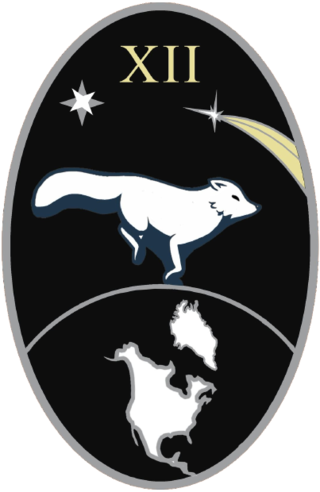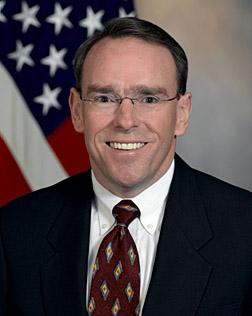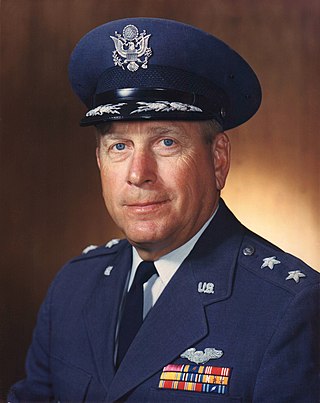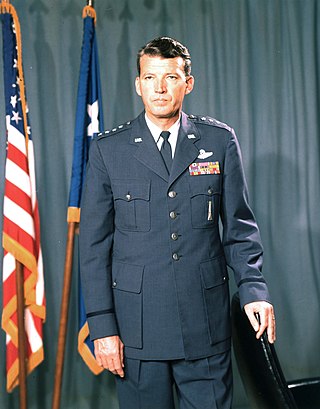
Lt. Gen. Ronald T. Kadish, Ret. (born April 6, 1948) is a United States Air Force officer who rose to head the Ballistic Missile Defense Organization and the Missile Defense Agency within the United States Department of Defense.

Lt. Gen. Ronald T. Kadish, Ret. (born April 6, 1948) is a United States Air Force officer who rose to head the Ballistic Missile Defense Organization and the Missile Defense Agency within the United States Department of Defense.
Born in Kingston, Pennsylvania, Kadish attended the Cardinal O'Hara High School and earned a bachelor's degree in chemistry in 1970 from St. Joseph's University in Philadelphia [1] and joined the Air Force through the OTS program. He trained as a pilot on the C-130E aircraft and, as a pilot and instructor, logged over 2,500 flight hours.
By the early 1990s, Kadish had risen through the ranks to the posts of Program Director of the F-15, F-16, and C-17 programs at Wright-Patterson Air Force Base. From 1996 to 1999, he commanded the Electronic Systems Center at Hanscom Air Force Base, and in 1999 was named director of the Ballistic Missile Defense Organization in The Pentagon.
From January 2002 until his retirement in September 2004, Kadish headed the Missile Defense Agency. His name was circulated as a possible NASA administrator following the 2004 resignation of Sean O'Keefe. He now works at Booz Allen Hamilton.
| | |||
| | | ||
| | | ||
| | | | |
| 1st Row | Defense Distinguished Service Medal with oak leaf cluster | Air Force Distinguished Service Medal | Legion of Merit | |||||||||
|---|---|---|---|---|---|---|---|---|---|---|---|---|
| 2nd Row | Meritorious Service Medal with three oak leaf clusters | Air Medal | Air Force Commendation Medal with two oak leaf clusters | Air Force Outstanding Unit Award | ||||||||
| 3rd Row | Air Force Organizational Excellence Award with three oak leaf clusters | Combat Readiness Medal | Air Force Recognition Ribbon | National Defense Service Medal with two bronze stars | ||||||||
| 4th Row | Air Force Overseas Ribbon - Long | Air Force Longevity Service Award Ribbon with silver and bronze oak leaf clusters | Small Arms Expert Marksmanship Ribbon | Air Force Training Ribbon | ||||||||

The Strategic Defense Initiative (SDI), was a proposed missile defense system intended to protect the United States from attack by ballistic nuclear missiles. The program was announced in 1983, by President Ronald Reagan. Reagan called for a system that would render nuclear weapons obsolete, and to end the doctrine of mutual assured destruction (MAD), which he described as a "suicide pact". Elements of the program reemerged in 2019 under the Space Development Agency (SDA).
The United States Armed Forces are the military forces of the United States. The armed forces consist of six service branches: the Army, Marine Corps, Navy, Air Force, Space Force, and Coast Guard. All six armed services are among the eight uniformed services of the United States, along with the U.S. Public Health Service Commissioned Corps and the NOAA Commissioned Officer Corps.

National missile defense (NMD) refers to the nationwide antimissile program the United States has had in development since the 1990s. After the renaming in 2002, the term now refers to the entire program, not just the ground-based interceptors and associated facilities.

The Missile Defense Agency (MDA) is a component of the United States government's Department of Defense responsible for developing a comprehensive defense against ballistic missiles. It had its origins in the Strategic Defense Initiative (SDI) which was established in 1983 by Ronald Reagan and which was headed by Lt. General James Alan Abrahamson. Under the Strategic Defense Initiative's Innovative Sciences and Technology Office headed by physicist and engineer Dr. James Ionson, the investment was predominantly made in basic research at national laboratories, universities, and in industry. These programs have continued to be key sources of funding for top research scientists in the fields of high-energy physics, advanced materials, nuclear research, supercomputing/computation, and many other critical science and engineering disciplines—funding which indirectly supports other research work by top scientists, and which was most politically viable to fund from appropriations for national defense. It was renamed the Ballistic Missile Defense Organization in 1993, and then renamed the Missile Defense Agency in 2002. The current director is U.S. Navy Vice Admiral Jon A. Hill.

The AN/FPS-108 COBRA DANE is a PESA phased array radar installation operated by Raytheon for the United States Space Force at Eareckson Air Station on the island of Shemya, Aleutian Islands, Alaska. The system was built in 1976 and brought online in 1977 for the primary mission of gathering intelligence about Russia's ICBM program in support of verification of the SALT II arms limitation treaty. Its single face 29 m (95 ft) diameter phased array radar antenna 52.7373°N 174.0914°E faces the Kamchatka Peninsula and Russia's Kura Test Range. COBRA DANE operates in the 1215–1400 MHz band and can track items as small as a basketball sized drone at distances of several hundred miles.

Claude Robert "Bob" Kehler, is a retired United States Air Force general who served as Commander, United States Strategic Command from January 28, 2011, to November 15, 2013. He previously served as Commander, Air Force Space Command from October 12, 2007, to January 5, 2011. As a commander of the Air Force Space Command, he was responsible for the development, acquisition and operation of the Air Force's space and missile systems. He oversaw a global network of satellite command and control, communications, missile warning and launch facilities, and ensured the combat readiness of America's intercontinental ballistic missile force. He led more than 39,700 space professionals in providing combat forces and capabilities to North American Aerospace Defense Command and U.S. Strategic Command. He was also responsible for the plans and operations for all U.S. forces conducting strategic deterrence and Department of Defense space and cyberspace operations. He officially retired from the Air Force on January 1, 2014, after nearly 39 years of service.

General Lester L. Lyles is a retired four-star general in the United States Air Force (USAF). He served as Vice Chief of Staff of the United States Air Force, and Commander, Air Force Materiel Command, Wright-Patterson Air Force Base, Ohio. After retirement from the USAF in 2003, he became a company director for General Dynamics, DPL Inc., KBR, Inc., Precision Castparts Corp., MTC Technologies, Battelle Memorial Institute and USAA. Lyles is also a trustee of Analytic Services and a managing partner of Four Seasons Ventures, LLC.

The 8th Air Division is an inactive United States Air Force organization. Its last assignment was with Air Defense Command, being stationed at McClellan Air Force Base, California. It was inactivated on 1 July 1957.

James Alan Abrahamson is a retired U.S. Air Force general who served as a designated astronaut, associate director of NASA and former director of President Ronald Reagan's Strategic Defense Initiative from 1984 until 1989. He is a businessman who served as chairman of the board of GeoEye, a company he helped to transform into the world's largest space imaging corporation and that merged with DigitalGlobe Inc in January 2013. Previously, he served as chairman of Oracle Corporation's board of directors from 1992 until 1995.

Lieutenant General Lincoln D. Faurer was United States Air Force officer who served as director of the National Security Agency and chief of the Central Security Service from 1981 to 1985.

Space Systems Command (SSC) is the United States Space Force's space development, acquisition, launch, and logistics field command. It is headquartered at Los Angeles Air Force Base, California, and manages the United States' space launch ranges.

Samuel Cochran Phillips was a United States Air Force general who served as Director of NASA's Apollo program from 1964 to 1969, as commander of the Space and Missile Systems Organization (SAMSO) from 1969 to 1972, as the seventh Director of the National Security Agency from 1972 to 1973, and as commander of the Air Force Systems Command from 1973 to 1975.

The 12th Space Warning Squadron is a United States Space Force ground-based radar used for missile warning, missile defense, and space situation awareness, stationed at Pituffik Space Base, Greenland.

John Jacob Young Jr. was United States Assistant Secretary of the Navy from 2001 to 2005 and Under Secretary of Defense for Acquisition, Technology and Logistics from 2007 to 2009. He is the founder and principal of JY Strategies, LLC.

James Edward Dalton is a former general and former chief of staff of the Supreme Headquarters Allied Powers Europe.

Terrence John O'Shaughnessy is a retired United States Air Force four-star general who previously served as the commander of United States Northern Command and as the commander of North American Aerospace Defense Command.

The 71st Flying Training Wing is a United States Air Force unit assigned to Air Education and Training Command. Stationed as the host unit of Vance Air Force Base, it has conducted pilot training for the U.S. Air Force and allied nations since 1972.

Joseph Sylvester Bleymaier was a major general in the United States Air Force (USAF). He enlisted in the United States Army Air Corps in 1941, and flew 25 combat missions in the Southwest Pacific Area during World War II.

Michael Anthony Guetlein is a United States Space Force general who serves as the second vice chief of space operations. He recently served as the first commander of Space Systems Command from 2021 to 2024. He previously served as the deputy director of the National Reconnaissance Office from 2019 to 2021.

While the United States Space Force gained its independence on 20 December 2019, the history of the United States Space Force can be traced back to the beginnings of the military space program following the conclusion of the Second World War in 1945. Early military space development was begun within the United States Army Air Forces by General Henry H. Arnold, who identified space as a crucial military arena decades before the first spaceflight. Gaining its independence from the Army on 18 September 1947, the United States Air Force began development of military space and ballistic missile programs, while also competing with the United States Army and United States Navy for the space mission.